Nanowire arrays with programmable geometries as a highly effective anti-biofilm surface
IF 4.9
Q1 MICROBIOLOGY
引用次数: 0
Abstract
Biofilm-related microbial infections are the Achilles’ heel of many implantable medical devices. Surface patterning with nanostructures in the form of vertically aligned silicon (Si) nanowires (VA-SiNWs) holds promise to prevent these often “incurable” infections. In this study, we fabricated arrays of highly ordered SiNWs varying in three geometric parameters, including height, pitch size, and tip diameter (sharpness). Anti-infective efficacies of fabricated SiNW arrays were assessed against representative laboratory reference bacterial strains, Staphylococcus aureus ATCC 25923 and Escherichia coli ATCC 25922, using a modified microwell biofilm assay representing microorganism-implant interactions at a liquid-solid interface. To further understand the role of individual geometric parameters to the SiNW-induced bacterial killing, SiNW arrays with stepwise changes in individual geometric parameters were compared. The force that NWs applied on bacterial cells was mathematically calculated. Our results suggested that NWs with specific geometries were able to kill adherent bacterial cells and prevent further biofilm formation on biomaterial surfaces. Tip diameter and pitch size appeared to be key factors of nanowires predetermining their anti-infectiveness. Mechanistic investigation found that tip diameter and pitch size co-determined the pressure that NWs put on the cell envelope. The most effective anti-infective NWs fabricated in our study (50 nm in tip diameter and 400 nm in pitch size for S. aureus and 50 nm in tip diameter and 800 nm in pitch size for E. coli) put pressures of approximately 2.79 Pa and 8.86 Pa to the cell envelop of S. aureus and E. coli, respectively, and induced cell lyses. In addition, these NWs retained their activities against clinical isolates of S. aureus and E. coli from patients with confirmed device-related infections and showed little toxicity against human fibroblast cells and red blood cells.
具有可编程几何形状的纳米线阵列作为一种高效的抗生物膜表面
生物膜相关的微生物感染是许多植入式医疗器械的致命弱点。以垂直排列的硅(Si)纳米线(VA-SiNWs)形式的纳米结构的表面图案有望预防这些通常“无法治愈”的感染。在这项研究中,我们制造了高度有序的sinw阵列,其几何参数包括高度、节距大小和尖端直径(锐度)。采用改进的微孔生物膜法,对制备的SiNW阵列对代表性实验室参考菌株金黄色葡萄球菌(Staphylococcus aureus) ATCC 25923和大肠杆菌(Escherichia coli) ATCC 25922的抗感染效果进行了评估,该方法代表了微生物与植入物在液固界面的相互作用。为了进一步了解单个几何参数对SiNW诱导细菌杀灭的作用,我们比较了单个几何参数逐步变化的SiNW阵列。用数学方法计算了NWs对细菌细胞施加的力。我们的研究结果表明,具有特定几何形状的NWs能够杀死附着的细菌细胞,并阻止生物材料表面进一步形成生物膜。针尖直径和节距大小是决定纳米线抗感染能力的关键因素。机制研究发现,尖端直径和节距大小共同决定了NWs对细胞包膜施加的压力。本研究制备的最有效的抗感染NWs(金黄色葡萄球菌的尖端直径为50 nm,间距为400 nm,大肠杆菌的尖端直径为50 nm,间距为800 nm)分别对金黄色葡萄球菌和大肠杆菌的细胞膜施加约2.79 Pa和8.86 Pa的压力,并诱导细胞裂解。此外,这些NWs保留了对临床分离的金黄色葡萄球菌和大肠杆菌的活性,这些临床分离的金黄色葡萄球菌和大肠杆菌来自确诊的器械相关感染的患者,并且对人成纤维细胞和红细胞的毒性很小。
本文章由计算机程序翻译,如有差异,请以英文原文为准。
求助全文
约1分钟内获得全文
求助全文

 求助内容:
求助内容: 应助结果提醒方式:
应助结果提醒方式:


